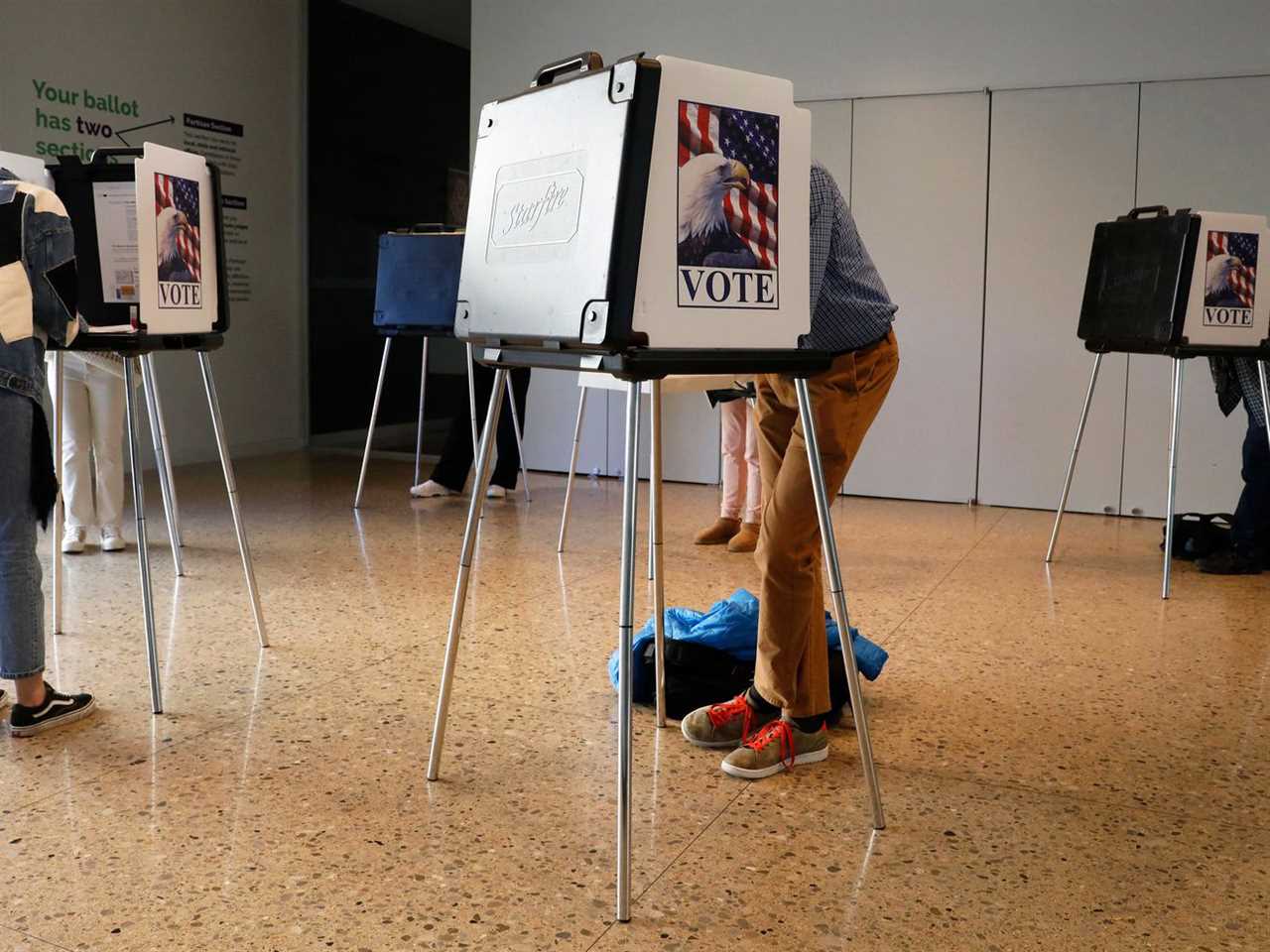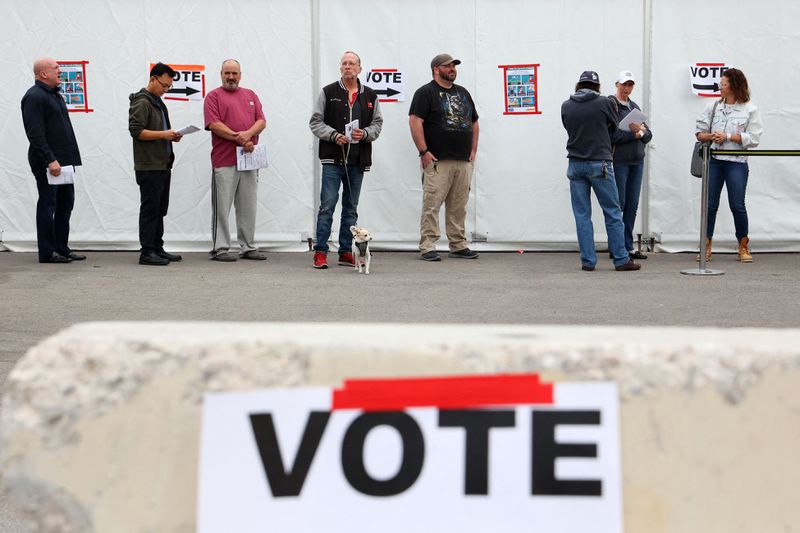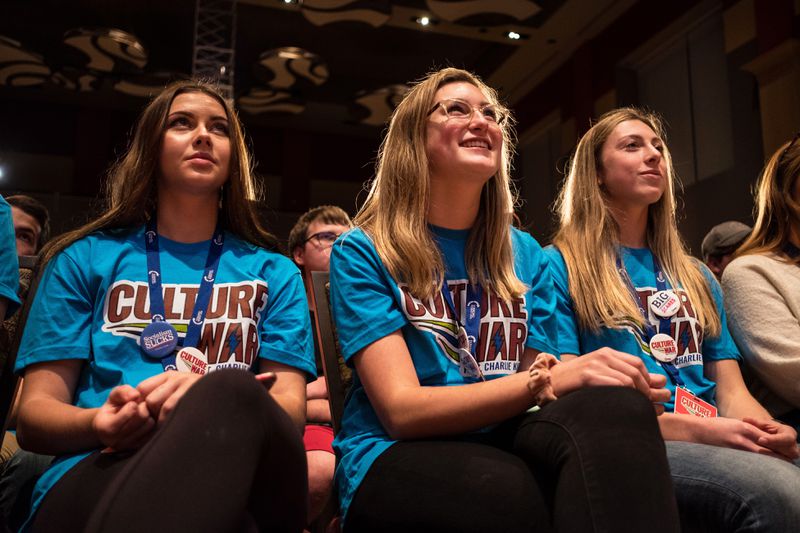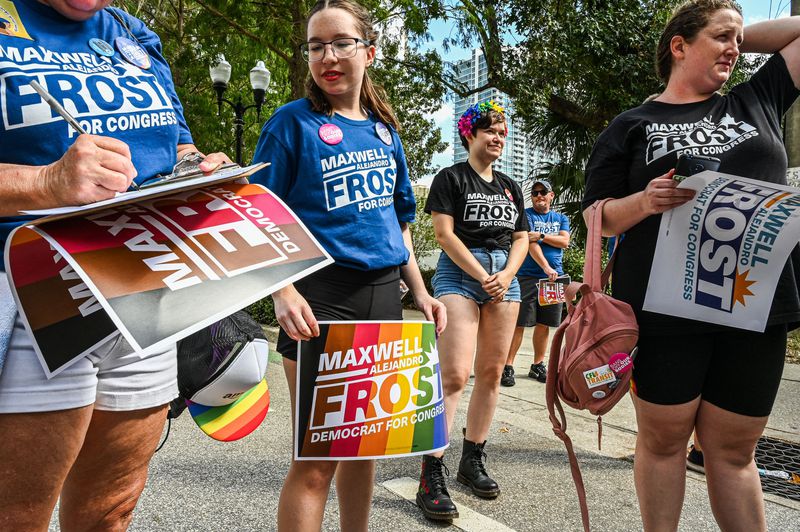
Democrats have long assumed young voters would save them, but both parties have badly misunderstood what drives young people to vote.
If you paid attention to the news the day after the midterm elections this year, you probably witnessed a bit of what I call the Youth Voter Savior Complex — the belief that young voters are some mystical political force that will forever save Democrats.
“Shout out to all the young people (Gen Zers) who are saving America,” read one tweet from a top union leader. Over on Fox News, political commentators bemoaned the “indoctrination” of young people into one monolithic, leftist political movement stymying conservative priorities and electoral wins. MSNBC hosts praised young voters for saving Democrats, and at the White House, President Joe Biden thanked “young people” for voting in “historic numbers again” to save democracy.
That all runs counter to the facts: This year, young people appear to have made up a smaller portion of the electorate than in 2018, and they supported Democrats by a thinner margin than in the last two elections. And despite what you’ve heard, young people aren’t one single, amorphous voting bloc that will continue to vote the same way.
But still, plenty of older, professional people tend to talk about young people in strange ways. These days, “youth is saddled with the expectation of moral authority and benevolence,” the Atlantic’s Kaitlyn Tiffany wrote a few days after Election Day: “Gen Zers are cheered by some progressives as righteously angry and so good-hearted that America doesn’t deserve them.” She also compiled a few of the most bizarre tweets and statements from activists, celebrities, and politicians demonstrating this attitude — that young people are simply better than other Americans, and are therefore going to save Democrats/America/the world.
If this sounds familiar, it’s because it falls under the umbrella of an oft-repeated phrase in Democratic politics: “Demographics are destiny,” the saying goes, and a younger, more diverse electorate will inevitably change the country’s political balance and deliver liberal and progressive victories in the future. Given Democrats’ struggles in holding on to support from voters of color, independents, and working-class people, this year’s results from young voters should be a wake-up call for both parties, but especially Democrats. Despite the identity often ascribed to them, young voters aren’t special or unintelligible — they are just as complex as other voting demographics, and they aren’t monolithic.
They’re also not the sum of stereotypes that both progressives and right-wing pundits project as conventional wisdom — young voters are not all clamoring for full student loan cancellation, vote based on climate policy and marijuana legalization, or are “brainwashed” leftists. Those issues do matter to young people but, this year, they behaved like most other voters: They balanced concerns over abortion, the cost of living, and election denialism in making their decisions.
Experts, strategists, and candidates that I spoke with tell me both parties have misunderstood young voters and need new tactics and strategies to keep young people engaged and trusting in a political system that hasn’t always delivered for them. Yes, many young people are idealists in theory, but they’re also pragmatic at the voting booth. Politicians should recognize that and reflect it in their efforts to persuade young people to participate in elections.
Young voters, and Generation Z, aren’t better than anyone else, but to continue to ignore them is to cede understanding and influence over the segment of persuadable voters who (with millennials) will make up a majority of voters in the next decade.
The political earthquake that wasn’t
We still don’t know the exact makeup of the electorate that turned out to vote during the midterms (that depends ultimately on the release of the final voter files for each county and state). But thanks to exit polls, surveys, post-election polling, and certified vote totals, we do have a general idea of the coalition of voters that delivered Democratic victories.
Compared to the Republican coalition, it skewed younger, was more female, and was more moderate. It relied on crossover support from independents and Republican voters, and was essentially an anti-MAGA, anti-Trump coalition of traditional Democrats, new voters, and voters turned off by Republican election denialism and the overturning of Roe v. Wade.
Though it varies by state, it looks in general as though young voters did turn out in above-average numbers nationally. In most places, they didn’t exceed the turnout of 2018’s blue wave or the historic 2020 presidential election year, which saw the highest youth voter participation rate in recent memory. But young voters likely exceeded the levels of participation seen in the 2010 and 2014 midterms during the Obama years, when Democrats were dealt significant setbacks in Congress. In specific states, like Pennsylvania, Michigan, Nevada, and Georgia, their share of the electorate was closer to 2018 than 2014, while participation lagged in places like California, North Carolina, Texas, and Washington.

Ronda Churchill/AFP via Getty Images
Still, young voters weren’t the singular decisive voting bloc that tipped the scales of victory for Democrats this year. As I’ve reported, no group was more important to those victories than independent voters of all ages. Across the country, Republicans turned out with greater intensity than the Democratic base. That was the case in battleground states as well as traditionally Democratic states — and it meant victory in highly competitive places like Arizona, Georgia, Pennsylvania, Nevada, and Wisconsin, which hinged on winning over a majority of independent voters.
Among Democratic voter groups, turnout varied too. Young people may have turned out at a level higher than expected, but so did Asian American voters, women, college-educated voters, and Latino voters in certain states. It was these groups’ combined turnout in the places where it mattered that delivered victory — meaning no single demographic was responsible for Democratic success — especially not just young voters or Gen Z.
What stands out is the breakdown in young voters’ support for Democrats: Voters under 30 years old preferred Democratic candidates by 28 points (which, according to exit polls, is a 7-point drop from their support in 2018’s blue wave), making it the only age group that Democrats won by a large margin. That same dynamic shows up in AP Votecast’s measure of vote choice based on age: 53 percent of voters under the age of 30 supported Democrats this year compared to the 41 percent who supported Republicans. That margin is down from 2020 and 2018, when the margins were 25 points and 30 points respectively.
The Democratic advantage might not hold as young people grow older
Those results suggest an uphill challenge for Democrats moving forward. While turnout among young people exceeded expectations this year, that’s partly because of just how abysmally low participation by the youngest cohort of voters tends to be.
It’s also no coincidence that the last three elections have been unique election years, where Trump or Trumpism has been on the ballot. Whether Democrats can replicate that without Trump’s movement as a contrast hasn’t been tested yet, but Democrats have room for growth.
While they are more socially liberal, diverse, and open to progressive ideas than older generations, a large plurality still identify as politically moderate. They are mostly independents, eschewing partisan identity at a higher rate than older voters. And more liberal young people have less loyalty to the Democratic Party than their older peers — something that fueled Biden’s unpopularity for most of the year, when this group of voters abandoned him. Meanwhile, the gender gap among young people is also ballooning. Young women, especially women of color, are much more Democratic than young men, according to Tufts University’s Center for Information and Research on Civic Learning and Engagement. And rural youth are much more Republican than those who live in cities.
I highlight all these nuances because young people are often talked about with too broad a brush, and that generality obscures the challenges that Democrats will eventually have with this group of voters. Whether people get more conservative as they age is a perennial question of political science and folk wisdom — “if you’re under 30 and not a liberal, you have no heart, but if you’re over 30 and not conservative, you have no brain,” the saying goes. But research from the University of Chicago shows that, for most people, political beliefs are longstanding and stable, but liberals are more likely to become more conservative than the other way around as people grow older. That aligns with research from Chicago Booth’s Sam Peltzman, who argues that age 45 is when aging voters begin to change their political ideologies.
Whether today’s young people defy that trend — because of their experiences with climate change, the economy, racial discrimination, or populism — remains to be seen, but lately, America has become less liberal, even with young people entering the electorate. Morning Consult, a polling firm that has tracked the political ideology and beliefs of Americans over the last five years, has found a moderate shift permeating all age groups, mirroring a trend Gallup has also tracked: Even with new voters entering the electorate, America’s share of moderates and conservatives has remained mostly static. While Americans aged 18 to 34 are generally more liberal than older cohorts, the portion of those young people who identify as liberal has gradually shrunk by 10 percent since 2017.
That doesn’t mean there’s a rush of young people becoming conservatives — just that, at a time when voters say they’re uncertain about both parties, more people identify as moderates.
What both political parties, but especially Democrats, do now
Activists know this presents a future challenge. Cristina Tzintzún Ramirez, the executive director of the progressive youth activist group NextGen America, told me that despite the progressive tilt of young people, conservative organizers have been building a ground game over the last few years to make more inroads among young voters. “Democrats can’t count on Republicans just being so godawful that young people are going to surge in numbers in the Democratic Party.”
She told me NextGen organizers frequently ran into conservative youth organizers during their voter engagement efforts on college campuses this election year, and saw a conservative organizing strategy at work. “Democrats shouldn’t sleep on what the right wing will do with the youth vote,” she said. “When we were on campuses, we were running into Turning Point USA. We actually had some of our organizers try to be recruited by Turning Point USA. They know they can’t win the overall youth vote, but they know they can shave off margins, and that’s why it’s important to invest in organizing and speaking to young people.”

Megan Jelinger/AFP via Getty Images
Those outreach efforts by Republicans and conservative groups suggest that future efforts to turn out young voters may also become more of a persuasion game than liberals and Democrats currently play. Because of their more socially liberal beliefs, young people at the moment are assumed to be a lock for Democrats, a part of the base that simply needs to be turned out during election years.
Ramirez told me that organizing and outreach to young people has to meet these young people where they are: not necessarily talking about the most progressive or flashy proposal, but about personal issues, like the cost of living and individual rights, which cut across race and education. It turns out young people can be inspired with ideas of revolutionary change but also have pragmatic voting priorities similar to the average voter. “It was important for college-educated women that we spoke and talked to them about abortion because that was what they said was their top issue. But for non-college educated folks, especially folks that tended to be people of color, they wanted to talk about the economy and how we build an economy for all of us,” Ramirez said. “So we spoke to them about that. There isn’t one single issue — it’s about speaking to people’s pain, and people’s pain is different based on their lived experience and understanding.”
It’s also true that young people are simply not Democrats’ primary targets of voter mobilization efforts, campaign spending, and politicians’ stump speeches. Jenifer Fernandez Ancona, the co-founder and vice president of the progressive political organization Way to Win, told me that she thinks a better way for Democratic strategists, politicians, and donors to think about engaging young people is through “mobi-suasion” – that is, making people aware of Democrats’ victories and priorities and using those as a reason for young people to trust them. “What that does is it doesn’t assume that just because someone is under 35, or someone is black, or someone is a woman, that they’re going to vote for Democrats. You just can’t tell them where to vote and how to vote, we actually need to tell people why it’s important to vote. We need to make an argument.”
For example, in Way to Win’s 2022 research and focus groups, Fernandez Ancona said that young voters could not name signature Democratic accomplishments from the first half of Biden’s presidency beyond his promise to cancel up to $20,000 in student loans.
“Student loan forgiveness was the only thing that voters could basically name that Biden had done,” she said. On that front, Biden and Democrats could have made bolder arguments about how small progress on marijuana decriminalization, climate change, and gun safety were examples of what else young people could get if they turned out.
Way to Win also developed specific advertising and video messaging that centered voters instead of politicians or the Democratic Party. “The most effective overall message and frame that we found was this idea of ‘We need to come out and vote to protect our freedom.’ And that we, us, the voters, this diverse group of voters, are the ones who can move our country forward,” Fernandez Ancona said.
She also said that centering young voters as the protagonists of the midterms could help counter cynicism and disillusionment that is a hallmark of many young Americans’ relationship with political parties and electoral politics.
What broke through voter apathy was a message that “we’re the ones who decide what’s possible, and we’re going to take matters into our own hands, and we’re going to make this happen,” she said. That note of solidarity, and the ability to protect others, created a compelling message.
Taking the focus away from specific candidates, from saviors or once-in-a-lifetime political stars or populists, is also a way to ensure that young voters have longer-term hope in the political process. The language often used to describe political elections, where every cycle seems to be the most important election of our lifetimes and one heroic politician can deliver the impossible, inevitably dissatisfies the most progressive or idealistic young people.
“We have to be unafraid of talking about the big bold solutions we believe in, but we have to always say, ‘Look, we know we’re not going to get it tomorrow. I’m not going to lie to you,’” Maxwell Alejandro Frost, the first member of Generation Z to be elected to Congress, told me. “Different generations of politicians have lied to us, telling us ‘if you vote for me, this will happen.’ And that’s not how this works.”

Giorgio Viera/AFP via Getty Images
A former progressive organizer, Frost told me that during his campaign, he often faced two parallel pressures from Democrats and voters: to be the party’s salvation and to be the harbinger of new political power in Washington.
“But I’m one of 435 people — not to diminish the position — but to set the landscape of power for my people, for my community,” he said. “I’ve received so many amazing messages of people saying, ‘Maxwell, you’re going to save us, you’re going to save the party,’ and it’s very flattering, but no, I’m not. It’s not about me alone. No one politician is going to save us, and I don’t put my stock in one politician. It’s a movement of people.”
When talking to young progressives especially, he would roll out a bit of a civics lesson: talk about the big reforms and initiatives they wanted, but caveat it all with a reminder that he was one of 500 people who set agendas. “It’s a battle, and we’re not going to get it tomorrow, but if we give up, we’re never going to get it.”
Being clear about the long-term stakes of voting ensures that young people aren’t disillusioned. “It’s more than getting up the youth vote and being like, ‘Go vote, go vote, go vote.’ No, it’s ‘come build power.’ Voting is a mechanism for us to build that power. There’s more we need to do. And when you give them that message, people are more inclined to go vote than if you just say ‘go vote.’”
This understanding, that voting and electoral politics are part of a larger set of priorities and goals, is broader than any one political candidate or party. That was one consistent message I heard from the experts I spoke with: Parties simply don’t matter that much to Gen Z voters.
Such a broad, long-term strategy also relieves young people of the burden of being the political saviors that so many older people ascribe to them. Young voters are not nobler, wiser, or better than any other voter, and they aren’t naturally going to save American politics. They’re coming of political age during a disruptive, tumultuous era of political history forcing them to balance their idealistic hopes with reality. Politicians and parties have to speak to that tension — and not just in election years.
----------------------------------------
By: Christian Paz
Title: What America’s politicians get wrong about young voters
Sourced From: www.vox.com/policy-and-politics/23513464/young-voters-gen-z-turnout-midterm-democrats-progressive
Published Date: Tue, 20 Dec 2022 12:00:00 +0000






